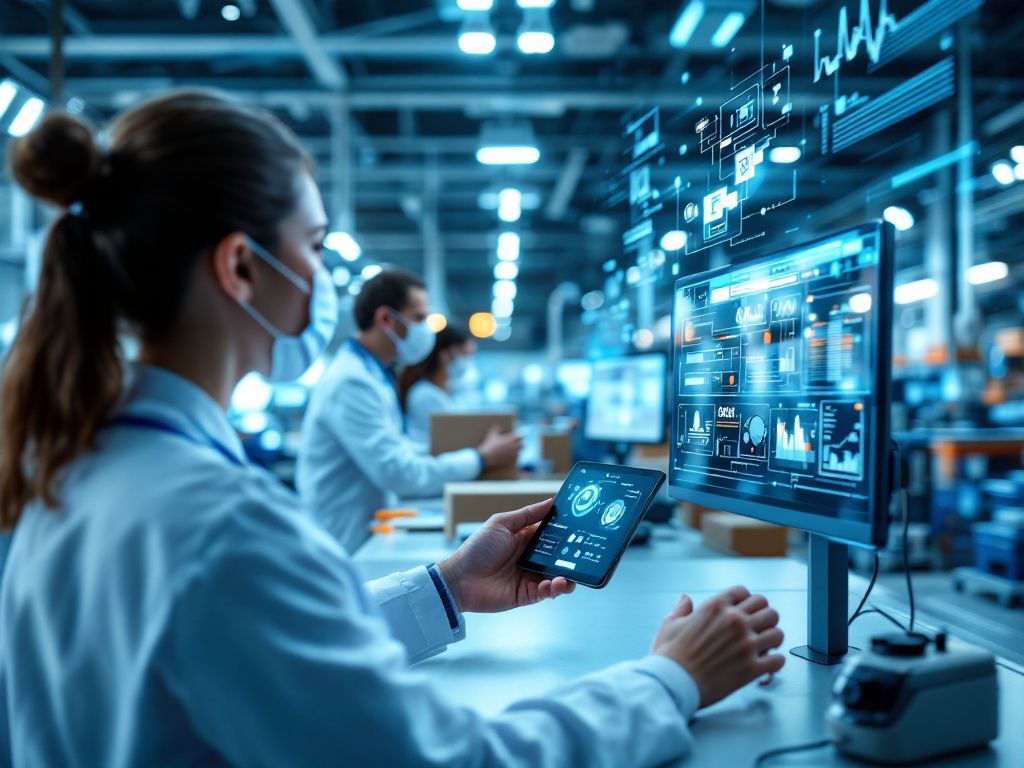
The Internet of Things represents a revolutionary shift in how devices communicate and interact within our digital ecosystem. From smart homes to industrial automation, IoT technologies are reshaping connectivity across sectors. Understanding its foundations, enabling technologies, industry impact, and future challenges is crucial for navigating this transformative landscape.
Understanding the foundations of IoT
The Internet of Things represents a paradigm shift in how physical objects interact with digital systems, creating unprecedented opportunities for connectivity and data exchange. At its core, IoT encompasses a network of physical devices embedded with sensors, software, and other technologies that enable them to collect and exchange data over the internet or other communication networks.
Core Components of IoT Systems
IoT systems function through four fundamental elements working in harmony. Sensors and devices serve as the foundation, detecting environmental changes such as temperature, humidity, light, motion, or pressure. These sensors are embedded within everyday objects, transforming them into smart, connected devices capable of real-world data collection.
Connectivity protocols enable seamless communication between devices and networks. Technologies like WiFi, cellular networks, Zigbee, and LoRaWAN facilitate efficient data transfer, allowing sensors to communicate with cloud platforms and other devices across various distances and power requirements.
Data Processing and Intelligence
The third component involves data processing and analysis, where collected information is analyzed locally or in the cloud to identify patterns, generate insights, and trigger automated responses. Modern IoT systems increasingly incorporate artificial intelligence and natural language processing capabilities, making devices more intelligent and responsive to user needs.
Finally, user interfaces and applications provide the means for humans to interact with IoT systems, offering real-time monitoring, control capabilities, and actionable insights derived from the connected device network.
Market Growth and Adoption
According to McKinsey research, the total value potential for the IoT ecosystem could reach significant levels by 2030, with industrial applications representing the largest share. IoT adoption spans numerous sectors, from smart home thermostats and fitness trackers to sophisticated industrial monitoring systems and smart city infrastructure, demonstrating the technology’s versatility and transformative potential across industries.

Key enabling technologies in IoT
The rapid evolution of IoT has been enabled by several breakthrough technologies that have converged to create today’s interconnected ecosystem. These foundational technologies have transformed theoretical concepts into practical solutions that businesses and consumers rely on daily.
Edge Computing and Cloud Infrastructure
Edge computing represents a paradigm shift in how IoT data is processed, bringing computational power closer to the source of data generation. This technology reduces latency from milliseconds to microseconds, enabling real-time decision-making crucial for applications like autonomous vehicles and industrial automation. Major cloud providers have recognized this potential, with Amazon Web Services expanding its edge computing offerings through AWS IoT Greengrass, while Microsoft Azure IoT Edge provides seamless integration between cloud and edge environments.
Cloud computing platforms have become the backbone of IoT infrastructure, offering scalable storage and processing capabilities. Oracle’s IoT Cloud Service exemplifies how enterprise-grade cloud solutions support massive IoT deployments, providing analytics and device management capabilities that can handle millions of connected devices simultaneously.
Connectivity Protocols and Standards
The diversity of connectivity options has been fundamental to IoT’s widespread adoption. Zigbee technology, standardized by the Zigbee Alliance (now part of the Connectivity Standards Alliance), enables low-power mesh networking ideal for smart home applications. This protocol operates on the IEEE 802.15.4 standard and supports up to 65,000 devices in a single network.
Bluetooth Low Energy (BLE) has evolved significantly, with Bluetooth 5.0 offering four times the range and eight times the data capacity of previous versions. Google’s integration of Bluetooth mesh networking in Android devices demonstrates how major technology companies are advancing connectivity standards.
Long-Range Wireless Solutions
LoRaWAN and other long-range wireless technologies have enabled IoT applications across vast geographical areas. These technologies support communication ranges exceeding 10 kilometers while maintaining extremely low power consumption, making them ideal for agricultural monitoring and smart city implementations.
Machine Learning and AI Integration
The integration of artificial intelligence and machine learning capabilities directly into IoT devices has created intelligent edge computing scenarios. Modern IoT systems can now process data locally, make autonomous decisions, and adapt to changing conditions without constant cloud connectivity. This advancement has been particularly significant in industrial IoT applications where real-time responses are critical for safety and efficiency.

The impact of IoT on industries
The transformative power of Internet of Things technology extends far beyond theoretical applications, fundamentally reshaping how industries operate, deliver services, and create value. From healthcare facilities to manufacturing plants, IoT is driving unprecedented changes in operational efficiency and business innovation.
Healthcare Revolution Through Connected Monitoring
The healthcare sector has emerged as one of the most significant beneficiaries of IoT technology, with healthcare IoT applications representing approximately 15 percent of the total IoT economic potential. Remote patient monitoring systems now enable healthcare providers to track vital signs, medication adherence, and chronic disease management in real-time, fundamentally changing patient care delivery models.
In the United States, hospitals are implementing IoT-enabled inventory management systems for pharmaceuticals and medical instruments, while wearable devices provide continuous health data collection. These connected solutions allow physicians to monitor patients remotely, reducing hospital readmissions and enabling early intervention for potential complications. IoT sensors in medical equipment also facilitate predictive maintenance, ensuring critical devices remain operational when needed most.
Manufacturing Excellence in Spain and Beyond
The industrial sector represents the largest opportunity for IoT value creation, with factory applications alone projected to generate up to $3.3 trillion by 2030. Spanish manufacturing companies are leveraging IoT for digital transformation initiatives that optimize production processes and enhance worker safety.
Smart manufacturing systems utilize connected sensors to monitor machine performance, predict equipment failures before they occur, and optimize energy consumption. In Spain, automotive and textile manufacturers are implementing IoT solutions for real-time quality control and supply chain optimization. These systems enable continuous machine monitoring to ensure operations remain within required tolerances while identifying potential issues before they impact production schedules.
Logistics and Supply Chain Innovation
IoT technology is revolutionizing logistics operations through enhanced asset tracking and fleet management capabilities. Connected devices provide real-time visibility into shipment locations, environmental conditions, and delivery schedules, enabling companies to optimize routes and reduce operational costs while improving customer satisfaction.

Challenges and future directions in IoT
While IoT continues to transform industries and drive innovation, several critical challenges must be addressed to unlock its full potential. These obstacles span technical, regulatory, and societal dimensions, requiring comprehensive solutions to ensure sustainable growth.
Security and Privacy Challenges in Connected Networks
The proliferation of connected devices has exponentially increased the attack surface for cybercriminals. As IoT networks expand, security vulnerabilities multiply, creating new entry points for malicious actors. Each connected device represents a potential gateway to broader network infrastructure, making comprehensive security protocols essential.
Privacy concerns intensify as IoT devices collect vast amounts of personal and operational data. The continuous monitoring capabilities of connected sensors raise questions about data ownership, consent, and usage rights. Organizations must navigate complex privacy regulations while maintaining the functionality that makes IoT valuable.
Interoperability and Standardization Issues
The lack of universal standards across IoT platforms creates significant integration challenges. Different manufacturers often use proprietary protocols, making seamless communication between devices from various vendors difficult. This fragmentation limits the scalability of IoT solutions and increases implementation costs for organizations seeking comprehensive connected ecosystems.
Emerging Solutions and Technological Advances
Natural Language Processing (NLP) is emerging as a powerful tool to address IoT complexity. By enabling more intuitive human-device interactions, NLP can simplify device management and reduce the technical expertise required for IoT deployment. Voice-activated controls and conversational interfaces make IoT systems more accessible to end-users.
Legislative and Regulatory Developments
Regulatory frameworks are evolving to address IoT challenges. California has implemented stringent IoT security regulations, requiring manufacturers to implement reasonable security features in connected devices. Similar legislative actions worldwide are establishing baseline security standards and privacy protections, creating a more secure foundation for IoT growth.
Future IoT development will likely focus on edge computing capabilities, enhanced AI integration, and standardized security protocols. Smart city initiatives represent a significant growth area, where coordinated IoT deployments can optimize urban infrastructure, energy consumption, and public services while addressing scalability and interoperability challenges.

The essential to remember about IoT transformation
The Internet of Things stands at the forefront of digital transformation, promising unprecedented connectivity and efficiency gains across industries. As we move forward, addressing security concerns, privacy issues, and interoperability challenges will be crucial for widespread adoption. Emerging technologies like Natural Language Processing and smart city initiatives point toward an increasingly interconnected future. Legislative actions worldwide will shape IoT development, while partnerships between technology leaders continue to advance capabilities. The potential for IoT to revolutionize how we live and work remains vast, with continuous innovation driving us toward a more connected world.